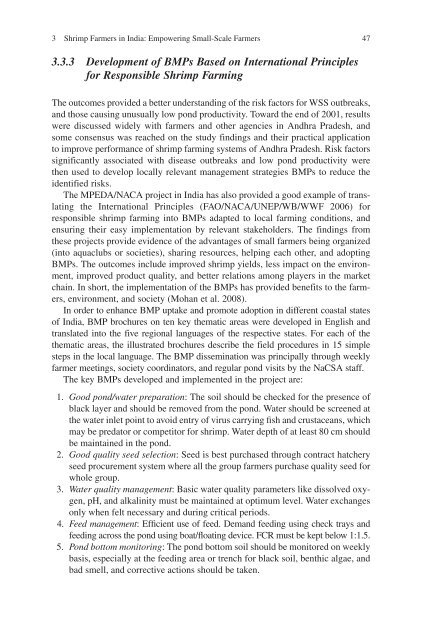Success Stories In Asian Aquaculture - Library - Network of ...
Success Stories In Asian Aquaculture - Library - Network of ...
Success Stories In Asian Aquaculture - Library - Network of ...
- No tags were found...
You also want an ePaper? Increase the reach of your titles
YUMPU automatically turns print PDFs into web optimized ePapers that Google loves.
3 Shrimp Farmers in <strong>In</strong>dia: Empowering Small-Scale Farmers473.3.3 Development <strong>of</strong> BMPs Based on <strong>In</strong>ternational Principlesfor Responsible Shrimp FarmingThe outcomes provided a better understanding <strong>of</strong> the risk factors for WSS outbreaks,and those causing unusually low pond productivity. Toward the end <strong>of</strong> 2001, resultswere discussed widely with farmers and other agencies in Andhra Pradesh, andsome consensus was reached on the study findings and their practical applicationto improve performance <strong>of</strong> shrimp farming systems <strong>of</strong> Andhra Pradesh. Risk factorssignificantly associated with disease outbreaks and low pond productivity werethen used to develop locally relevant management strategies BMPs to reduce theidentified risks.The MPEDA/NACA project in <strong>In</strong>dia has also provided a good example <strong>of</strong> translatingthe <strong>In</strong>ternational Principles (FAO/NACA/UNEP/WB/WWF 2006) forresponsible shrimp farming into BMPs adapted to local farming conditions, andensuring their easy implementation by relevant stakeholders. The findings fromthese projects provide evidence <strong>of</strong> the advantages <strong>of</strong> small farmers being organized(into aquaclubs or societies), sharing resources, helping each other, and adoptingBMPs. The outcomes include improved shrimp yields, less impact on the environment,improved product quality, and better relations among players in the marketchain. <strong>In</strong> short, the implementation <strong>of</strong> the BMPs has provided benefits to the farmers,environment, and society (Mohan et al. 2008) .<strong>In</strong> order to enhance BMP uptake and promote adoption in different coastal states<strong>of</strong> <strong>In</strong>dia, BMP brochures on ten key thematic areas were developed in English andtranslated into the five regional languages <strong>of</strong> the respective states. For each <strong>of</strong> thethematic areas, the illustrated brochures describe the field procedures in 15 simplesteps in the local language. The BMP dissemination was principally through weeklyfarmer meetings, society coordinators, and regular pond visits by the NaCSA staff.The key BMPs developed and implemented in the project are:1. Good pond/water preparation : The soil should be checked for the presence <strong>of</strong>black layer and should be removed from the pond. Water should be screened atthe water inlet point to avoid entry <strong>of</strong> virus carrying fish and crustaceans, whichmay be predator or competitor for shrimp. Water depth <strong>of</strong> at least 80 cm shouldbe maintained in the pond.2. Good quality seed selection : Seed is best purchased through contract hatcheryseed procurement system where all the group farmers purchase quality seed forwhole group.3. Water quality management : Basic water quality parameters like dissolved oxygen,pH, and alkalinity must be maintained at optimum level. Water exchangesonly when felt necessary and during critical periods.4. Feed management : Efficient use <strong>of</strong> feed. Demand feeding using check trays andfeeding across the pond using boat/floating device. FCR must be kept below 1:1.5.5. Pond bottom monitoring : The pond bottom soil should be monitored on weeklybasis, especially at the feeding area or trench for black soil, benthic algae, andbad smell, and corrective actions should be taken.
















